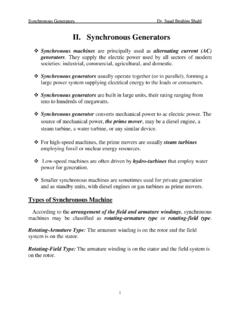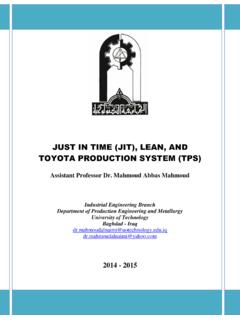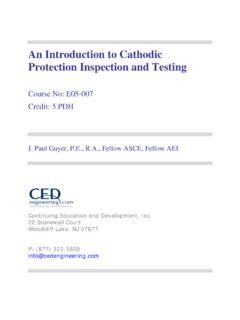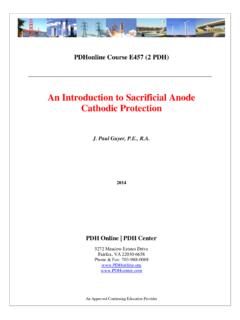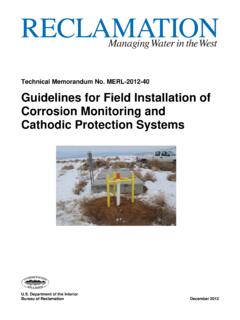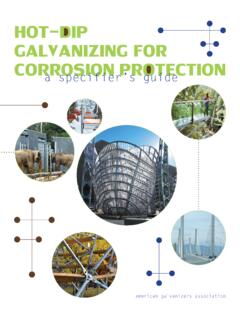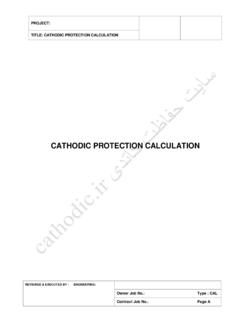Transcription of Cathodic Protection of Storage Tank
1 Republic of Iraq Ministry of Higher Education and Scientific ResearchUniversity of TechnologyChemical Engineering DepartmentCathodic Protectionof Storage TankA Project Submitted To The Chemical EngineeringDepartment Of The University Of Technology InPartial Fulfilment Of The Requirements for the DegreeOf Higher Diploma In Chemical Engineering -Petroleum And Gas RefiningByRana M. in Chemical Engineering - Petroleum And Gas Refining 2000 Supervised A. SamehFebruary 2012 SUPERVISOR CERTIFICATION I certify that this project entitled Cathodic Protection Of Storage Tank was prepared under my supervision as a partial fulfilment of the requirements for the degree of Higher Diploma Science in Chemical Engineering at the Chemical Engineering- Department , University of Technology. Signature : Dr.
2 Shatha A. Sameh Assistant Professor Supervisor Data: / /2012 In view of the available recommendations, I forward this research for debate by the Examination Committee. Signature: Dr. Mohamed I. Mohamed Assistant Professor Head of Post Graduate Committee Department of Chemical Engineering Data: / /2012 EXAMINATION COMMITTEE CERTIFICATE We certify that we have read this project entitled Cathodic Protection Of Storage Tank and as examining committee examined the student Rana M.
3 Hussain in its contents and that in our opinion it meets the standards of a project for the degree of Higher Diploma in Chemical Engineering Petroleum and Gas Refining . Signature : Dr. Shatha A. Sameh Supervisor Data: / /2012 Signature: Signature: Dr. Jamal M. Ali Dr. Issam K. Salih Member Chairman Date: / / 2012 Date: / / 2012 Signature: Prof. Dr. Momtaz A. Zabluk Head of the Chemical Engineering Department Date: / / 2012 AbstractICathodic Protection is an electrochemical means of corrosionprevention technique which uses the electrochemical properties of metals toinsure that the structure to be protected becomes the cathode of anelectrolytic cell.
4 The purpose of present work is to construct Cathodic Protection (CP)system to prevent structures from corrosion . A case study for m3 crude oil Storage tank exists in DURA refinery was scope of work included the design and determination of all necessarymaterials for the internal Cathodic Protection of tank bottom and one meterheight of tank wall. utilizing Aluminum anodes as sacrificial anodes . The results showed that the Cathodic Protection required 230 anoderods (N), current output (one anode) = Amp , Minimum distancebetween anodes Lmin = m , Protecting diameter for one anode Danode = m . List of Tables VI CHAPTER TWO Typical current density required for Cathodic Protection of uncoated steel (3- 1) PH value and corrosion (3- 2) Galvanic anode characterization (3- 3) Impressed current Anodic Material and their Properties (3-4)
5 List of Contents II Abstract I Abbreviation II Nomenclature III List of Figure V List of Table VI CHAPTER ONE / INTRODUCTION Introduction - 1 The aim of present work 2 CHAPTER TWO / THE PRINCIPLES OF CORROSION AND Cathodic Protection Introduction 3 Corrosion principles &mechanisms 4 Understanding Corrosion 4 Corrosion Cell 5 Cathodic & Anodic reactions 6 Common forms of corrosion 7 Corrosion damage 8 Corrosion Prevention 9 List of Contents III Materials Selection 9 Design Consideration 9 Corrosion Inhibition 10 Coating Control Corrosion 10 Cathodic Protection 10 Cathodic Protection & its relation to the electrochemical theory of corrosion 11 current density requirement 13 Sacrificial anode system 15 Introduction 15 Galvanic anode types 16 Advantages and Disadvantages 18 Advantages 18 Disadvantages 18 Impressed current 18 Introduction 18 Anodes 20 Advantages and Disadvantages 22 Advantages 22 Disadvantages 22 Cathodic Protection system Selection 23 Application 23 List of Contents IV CHAPTER THREE/ CASE STUDY Oil
6 Storage Tank 25 Requirements of the internal surface of Oil Storage Tank 27 Design Condition 27 Calculation 28 References List of Figures V CHAPTER TWO Corrosion cell ( 2- 1) current density system is explained (2- 2) Sacrificial Anode System ( 2-3) Impressed current System ( 2-4) CHAPTER THREE Layout of Storage tank (3- 1) Anode installation (3- 2) Anode layout plan for Aluminum (3- 3) Nomenclature III Symbol Meaning Unit D Diameter of tank m meter h Water level m meter Resistivity.
7 Cm .cm l Design current density mAp/m2 mA/m2 w Weight (for one anode) kg kg I current capacity of anode kg/Amp. year kg/A. year E Potential difference for anode in sea water mV mV St Tank bottom surface area to be protect m2 m Sr Tank shell area to be protect m2 m2 Stotal Total surface area to be protect m2 m2 Ttotal Total current required at design current density Amp Amp w Total weight of anode rods kg KG N Required number of anode ea. ea Sanode L min D anode Protected area by one anode m2 Minimum distance between anodes m Protecting diameter by one anode m m2 Nomenclature IV Ecorr Corrosion Potential volt icorr Corrosion current density A/cm2 chapter 1 INTRODUCTION 1 CHAPTER ONE INTRODUCTION Introduction Corrosion is defined as the chemical or electrochemical reaction between a material, usually a metal or alloy, and its environment that produces a deterioration of the material and its properties.
8 According to the characteristics of the environment, corrosion processes are classified as chemical or electrochemical . Corrosion is a costly worldwide problem. In addition to the huge cost in economic terms, corrosion is also blamed for many of the disasters that cause loss of life and devastating pollution to the environment. [1] Five different main principles can be used to prevent corrosion: appropriate materials selection, change of environment, suitable design application of coatings ,electrochemical Cathodic and anodic Protection ,. The choice between these possibilities is usually based upon economic considerations, but in many cases aspects such as appearance, environment and safety must also be taken care of. Two or more of the five principles are commonly used at the same time. [2] Corrosion occurs on all metallic structures that are not adequately protected.
9 The cost of replacing a structure which may have been destroyed or weakened due to excessive corrosion is substantial but avoidable, and means should be taken to consistently prevent or mitigate this added cost through Cathodic Protection [3] chapter 1 INTRODUCTION 2 Cathodic Protection (CP) is a technique to control the corrosion of a metal surface by making it the cathode of an electrochemical cell. The simplest method to apply CP is by connecting the metal to be protected with another more easily corroded metal to act as the anode of the electrochemical cell. Cathodic Protection systems are most commonly used to protect steel of water or fuel pipelines , Storage tanks, steel pier piles, water-based vessels including yachts and powerboats, offshore oil platforms and onshore oil well casings.
10 Today, galvanic or sacrificial anodes are made in various shapes using alloys of zinc, magnesium and aluminium. The electrochemical potential, current capacity, and consumption rate of these alloys are superior for CP than iron. [4] The aim of present work The purpose of present work is to construct Cathodic Protection (CP) system to prevent structures from corrosion by utilizing Aluminum anodes as sacrificial anodes. Chapter 2 THE PRINCIPLES OF CORROSION AND Cathodic PROTECCTIONO 3 CHAPTER TWO THE PRINCIPLES OF CORROSION AND Cathodic Protection Introduction Corrosion refers to the deterioration of a material due to reactions with its environment .[5] In nature, most metals are found in a chemically combined state known as ore. Ores may be oxides, Sulphides, Cabronates or other complex compounds. In order to separate a metal such as iron from one of its ores, iron oxide, it is necessary to supply a large amount of energy.


